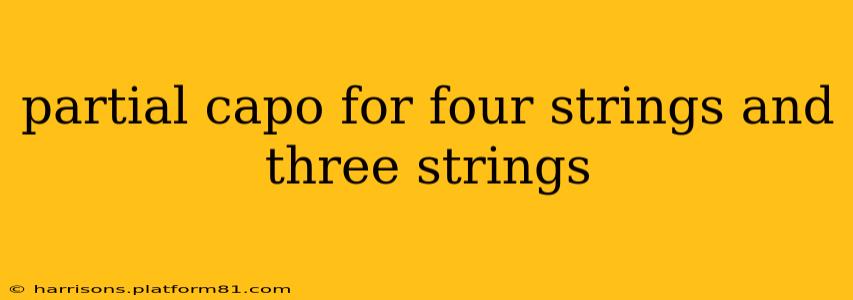The partial capo, a musician's clever trick, offers a world of tonal possibilities by selectively raising the pitch of specific strings. Whether you're a seasoned guitarist or just starting, understanding how to utilize partial capos for four and three strings can unlock new creative avenues. This guide delves into the techniques and applications of this versatile tool.
What is a Partial Capo?
Unlike a full capo, which clamps down on all six strings, a partial capo only affects a select number of strings. This allows for unique voicings, open tunings without retuning, and the creation of interesting chord shapes. Think of it as a customizable tuning device for individual strings, opening doors to sounds that would otherwise be inaccessible. Many players employ readily available materials to achieve this effect, like rubber bands, pencils, or specialized partial capo devices.
Four-String Partial Capo Techniques
Using a partial capo on four strings is incredibly common. Popular applications often involve raising the pitch of the top four strings, leaving the lower two strings open. This technique frequently imitates the sound of open tunings, particularly useful for creating slide guitar-esque effects, adding a unique timbre to your music, or simplifying chord shapes for certain songs.
How to Use a Four-String Partial Capo
The application depends greatly on your chosen method. If using a commercially available partial capo, follow the manufacturer's instructions. For DIY methods (like using a rubber band or pencil), ensure the capo is securely positioned without muting the strings or causing undue tension. Experiment with placement to find the sweet spot that balances pressure and clear sound.
Three-String Partial Capo Techniques
A three-string partial capo can produce even more specialized sounds. This technique offers a high degree of control, allowing you to isolate specific string combinations, which opens up an extensive range of sonic possibilities. Common uses involve targeting the three highest strings, often to achieve a brighter tone, or selecting other combinations to experiment with voicings.
How to Use a Three-String Partial Capo
Similar to the four-string method, precise placement is key. Using a specialized three-string capo is ideal, but resourceful musicians can create a three-string partial capo using modified DIY methods. This might involve careful application of rubber bands or small clips, ensuring they are correctly positioned to avoid muting or unwanted vibrations.
What are the benefits of using a partial capo?
This is a question many musicians ponder. The advantages are manifold:
- Simpler Chord Shapes: Partial capos can transform complex chord shapes into easier-to-play versions, allowing for faster transitions and more fluid playing.
- New Chord Voicings: Experimenting with different string combinations reveals entirely new sonic landscapes and chord voicings that would be impossible without a partial capo.
- Open Tuning Sounds without Retuning: Replicate the sound of various open tunings without the inconvenience of constantly retuning your instrument. This is a time-saver for live performances.
- Unique Timbre and Tone: Adding a partial capo alters the overall timbre of your guitar, adding brightness, depth, or other textural elements.
What are the drawbacks of using a partial capo?
While partial capos are very useful, they are not without their minor drawbacks:
- Potential for Muting: Improper placement or excessive pressure can lead to muted strings, resulting in an unclean sound.
- Intonation Issues: In some cases, the increased tension on certain strings might slightly affect intonation. Careful placement and adjustment are critical.
- Requires Practice: Mastering the application of a partial capo takes time and practice to achieve a clear, consistent sound.
What materials can be used to make a partial capo?
Many musicians improvise their own partial capos using readily available materials, such as:
- Rubber Bands: These are cost-effective, easily adjustable, and widely accessible.
- Pencils or Pens: These provide a slightly more rigid approach, but precise placement is crucial to avoid muting.
- Clips or Clamps: Small, modified clips or clamps can provide a more secure and consistent method.
Remember, safety and proper technique are paramount; experiment cautiously to avoid damaging your instrument.
Conclusion: Embrace the Versatility of the Partial Capo
The partial capo, whether for four or three strings, unlocks a universe of creative possibilities. By understanding its techniques and applications, you can add a distinctive element to your guitar playing, expanding your musical palette and enhancing your creative expression. Experimentation is key, so grab your guitar, and start exploring the limitless sonic landscapes opened by the partial capo!
